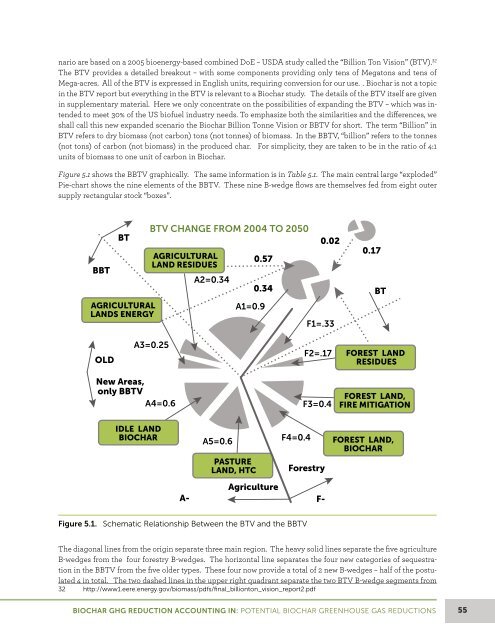1 hectare (ha) = 2.47 acres; 100 hectares = 1 square kilometer. 1 square mile = 2.59 sq. km;1 kg = 2.205 pounds; 1000 grams = 1 kilogram; 1000 kg = 1 tonne (t); 1 tonne=1.102 tonsCarbon weight and what to call itThe world of carbon avoidance and carbon removal is mostly (not universally) using carbon, and not carbondioxide, as the standard unit. We have about 800 GtC in the atmosphere now and many climate experts wouldlike to remove about 200 GtC. However, the US’ Energy Information Administration (EIA) has just switched to<strong>report</strong>ing CO 2 . 30 The relationship between the two is by atomic weight ratio 44/12 = 3.67. Despite EIA, we shallstick with C, not CO 2 , as the more basic unit for <strong>Biochar</strong>. If we have 1 t C, that carbon is equivalent to 3.67 t of CO 2 .The term “wedge” was coined by two Princeton Professors 31 to mean the avoidance of 25 GtC over a 50 year periodof linear growth (a triangle shape) assuming the linear growth ends with 1 GtC/yr of avoidance. This assumescarbon-neutral capabilities from energy technology areas like energy efficiency, solar, wind, biomass, nuclear, etc.They have never mentioned <strong>Biochar</strong>.However, “wedge” has also come to mean the end annual rate (of 1GtC /year) value as well. The concept fits wellwith <strong>Biochar</strong>, with the same annual rate units (weight/time). However, for <strong>Biochar</strong>, we have the added complexityof needing to talk about three variables: biomass rate units, <strong>Biochar</strong> rate units, and carbon rate units. In order totake advantage of the shorthand that the term “wedge” offers, but limit ourselves to the end-value meaning, wewill introduce two new terms:”B-wedges” and “C-wedges”.• B-wedge is the unit of annual biomass harvested supply- measured in annual tonnes of biomass GtB/yr.• C-wedge is the amount of carbon (not char) annually placed in the ground, measured as GtC/yr.One needs to produce more than 1 tonne of char to obtain one tonne of carbon in the char. Those paying forsequestration will be paying for tonnes of carbon sequestered, not tonnes of char.Productivity unitsThis is the term P in Equation 5-1. Because it is hard for most of us to visualize tonnes and hectares, we only showbiomass productivity in a more easily visualized form: kg/m2-yr. This unit is one tenth the numerical value givenin Eq. 5-1. That is, 1 kg/m2-yr is the same as 10t/ha-yr.Carbon-neutral aspects of <strong>Biochar</strong>.There are a range of possible carbon-neutral impacts for <strong>Biochar</strong> - about which more is said in subsection 5.5.3.The time required.The proposed 1 C-wedge goal for the US <strong>Biochar</strong> industry is a long-term peak goal. However, it is perceived asbeing possible before 2050. The year 2030 is probably (but not completely) out of the question, as that wouldrequire immediate action and a worldwide commitment that is not yet evident.5.4 Our Projection – A <strong>Biochar</strong> Billion Tonne Vision (BBTV) Scenario5.4.1 Summary Figure and Table.Using the above framework, the required numbers described above for weights and areas for our 1 C-Wedge sce-30 http://www.eia.doe.gov/oiaf/1605/ggrpt/carbon.html31 http://carbonsequestration.us/Papers-presentations/htm/Pacala-Socolow-ScienceMag-Aug2004.pdf54U.S.-Focused <strong>Biochar</strong> Report:Assessment of <strong>Biochar</strong>’s Benefits for the United States of America
nario are based on a 2005 bioenergy-based combined DoE – USDA study called the “Billion Ton Vision” (BTV). 32The BTV provides a detailed breakout – with some components providing only tens of Megatons and tens ofMega-acres. All of the BTV is expressed in English units, requiring conversion for our use. . <strong>Biochar</strong> is not a topicin the BTV <strong>report</strong> but everything in the BTV is relevant to a <strong>Biochar</strong> study. The details of the BTV itself are givenin supplementary material. Here we only concentrate on the possibilities of expanding the BTV – which was intendedto meet 30% of the US biofuel industry needs. To emphasize both the similarities and the differences, weshall call this new expanded scenario the <strong>Biochar</strong> Billion Tonne Vision or BBTV for short. The term “Billion” inBTV refers to dry biomass (not carbon) tons (not tonnes) of biomass. In the BBTV, “billion” refers to the tonnes(not tons) of carbon (not biomass) in the produced char. For simplicity, they are taken to be in the ratio of 4:1units of biomass to one unit of carbon in <strong>Biochar</strong>.Figure 5.1 shows the BBTV graphically. The same information is in Table 5.1. The main central large “exploded”Pie-chart shows the nine elements of the BBTV. These nine B-wedge flows are themselves fed from eight outersupply rectangular stock “boxes”.BBTAGRICULTURALLANDS ENERGYOLDBTNew Areas,only BBTVBTV CHANGE FROM 2004 TO 2050A3=0.25A4=0.6IDLE LANDBIOCHARAGRICULTURALLAND RESIDUESA2=0.34A5=0.60.570.34A1=0.9PASTURELAND, HTCF4=0.4F1=.33AgricultureA- F-0.02F2=.17F3=0.4Forestry0.17BTFOREST LANDRESIDUESFOREST LAND,FIRE MITIGATIONFOREST LAND,BIOCHARBBTVBTVAgricultLandEnergA5OldAreasNewAreas,onlyBBTVIdlLanBiochFigure 5.Figure 5.1. Schematic Relationship Between the BTV and the BBTVThe diagonal lines from the origin separate three main region. The heavy solid lines separate the five agricultureB-wedges from the four forestry B-wedges. The horizontal line separates the four new categories of sequestrationin the BBTV from the five older types. These four now provide a total of 2 new B-wedges – half of the postulated4 in total. The two dashed lines in the upper right quadrant separate the two BTV B-wedge segments from32 http://www1.eere.energy.gov/biomass/pdfs/final_billionton_vision_<strong>report</strong>2.pdf<strong>Biochar</strong> GHG reduction accounting in: Potential <strong>Biochar</strong> Greenhouse Gas Reductions55
















